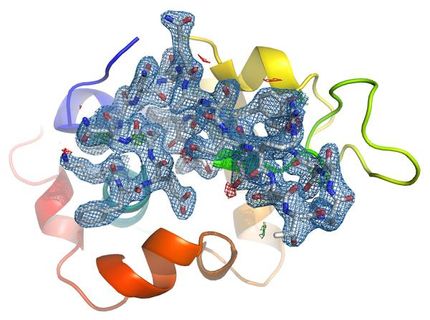Instant messaging in proteins discovered
Researchers unravel fundamental communication processes in proteins
proteins are essential for every living cell and responsible for many fundamental processes. In particular, they are required as bio-catalysts in metabolism and for signalling inside the cell and between cells. Many diseases come about as a result of failures in this communication, and the origins of signalling in proteins have been a source of great scientific debate. Now, for the first time, a team of researchers at the University of Göttingen has actually observed the mobile protons that do this job in each and every living cell, thus providing new insights into the mechanisms.

Lisa-Marie Funk, co-first author, analysing the mechanism of a protein using specialist biophysical methods in the lab.
Nora Eulig
Researchers from the University of Göttingen led by Professors Kai Tittmann and Ricardo Mata found a way to grow high-quality protein crystals of a human protein. The DESY particle accelerator in Hamburg made it possible to observe protons (subatomic particles with a positive charge) moving around within the protein. This surprising “dance of the protons” showed how distant sections of the protein were able to communicate instantaneously with each other – like electricity moving down a wire.
In addition, Tittmann’s group obtained high-resolution data for several other proteins, showing in unprecedented detail the structure of a kind of hydrogen bond where two heavier atoms effectively share a proton (known as “low-barrier hydrogen bonding”). This was the second surprise: the data proved that low-barrier hydrogen bonding indeed exists in proteins resolving a decades-long controversy, and in fact plays an essential role in the process.
“The proton movements we observed closely resemble the toy known as a Newton’s cradle, in which the energy is instantly transported along a chain of suspended metal balls. In proteins, these mobile protons can immediately connect other parts of the protein,” explained Tittmann, who is also a Max Planck Fellow at the Max Planck Institute for Biophysical Chemistry in Göttingen. The process was simulated with the help of quantum chemical calculations in Professor Mata’s laboratory. These calculations provided a new model for the communication mechanism of the protons. “We have known for quite some time that protons can move in a concerted fashion, like in water for example. Now it seems that proteins have evolved in such a way that they can actually use these protons for signalling.”
The researchers believe this breakthrough can lead to a better understanding of the chemistry of life, improve the understanding of disease mechanisms and lead to new medications. This advance should enable the development of switchable proteins that can be adapted to a multitude of potential applications in medicine, biotechnology and environmentally friendly chemistry.
Original publication
Most read news
Original publication
Organizations
Other news from the department science

Get the life science industry in your inbox
By submitting this form you agree that LUMITOS AG will send you the newsletter(s) selected above by email. Your data will not be passed on to third parties. Your data will be stored and processed in accordance with our data protection regulations. LUMITOS may contact you by email for the purpose of advertising or market and opinion surveys. You can revoke your consent at any time without giving reasons to LUMITOS AG, Ernst-Augustin-Str. 2, 12489 Berlin, Germany or by e-mail at revoke@lumitos.com with effect for the future. In addition, each email contains a link to unsubscribe from the corresponding newsletter.


















































